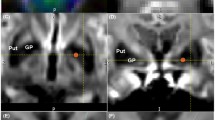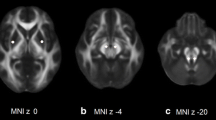Abstract
Objectives
We used neurite orientation dispersion and density imaging (NODDI) to quantify changes in the substantia nigra pars compacta (SNpc) and striatum in Parkinson disease (PD).
Methods
Diffusion-weighted magnetic resonance images were acquired from 58 PD patients and 36 age- and sex-matched controls. The intracellular volume fraction (Vic), orientation dispersion index (OD), and isotropic volume fraction (Viso) of the basal ganglia were compared between groups. Multivariate logistic regression analysis determined which diffusion parameters were independent predictors of PD. Receiver operating characteristic (ROC) analysis compared the diagnostic accuracies of the evaluated indices. Pearson coefficient analysis correlated each diffusional parameter with disease severity.
Results
Vic in the contralateral SNpc and putamen were significantly lower in PD patients than in healthy controls (P < 0.00058). Vic and OD in the SNpc and putamen showed significant negative correlations (P < 0.05) with disease severity. Multivariate logistic analysis revealed that Vic (P = 0.0000046) and mean diffusivity (P = 0.019) in the contralateral SNpc were the independent predictors of PD. In the ROC analysis, Vic in the contralateral SNpc showed the best diagnostic performance (mean cutoff, 0.62; sensitivity, 0.88; specificity, 0.83).
Conclusion
NODDI is likely to be useful for diagnosing PD and assessing its progression.
Key Points
• Neurite orientation dispersion and density imaging (NODDI) is a new diffusion MRI technique
• NODDI estimates neurite microstructure more specifically than diffusion tensor imaging
• By using NODDI, nigrostriatal alterations in PD can be evaluated in vivo
• NOODI is useful for diagnosing PD and assessing its disease progression




Similar content being viewed by others
Abbreviations
- DTI:
-
Diffusion tensor imaging
- DWI:
-
Diffusion-weighted imaging
- EPI:
-
Echo-planar imaging
- FA:
-
Fractional anisotropy
- MD:
-
Mean diffusivity
- NODDI:
-
Neurite orientation dispersion and density imaging
- OD:
-
Orientation dispersion index
- PD:
-
Parkinson disease
- rFOV:
-
Rreduced field-of-view
- ROC:
-
Receiver operating characteristic
- ROIs:
-
Regions of interest
- SNpc:
-
Substantia nigra pars compacta
- Vic:
-
Intracellular volume fraction
- Viso:
-
Isotropic volume fraction
References
Schulz-Schaeffer WJ (2010) The synaptic pathology of alpha-synuclein aggregation in dementia with Lewy bodies, Parkinson's disease and Parkinson's disease dementia. Acta Neuropathol 120:131–143
Patt S, Gertz HJ, Gerhard L, Cervos-Navarro J (1991) Pathological changes in dendrites of substantia nigra neurons in Parkinson’s disease: a Golgi study. Histol Histopathol 6:373–380
Zaja-Milatovic S, Milatovic D, Schantz AM et al (2005) Dendritic degeneration in neostriatal medium spiny neurons in Parkinson disease. Neurology 64:545–547
Deutch AY (2006) Striatal plasticity in parkinsonism: dystrophic changes in medium spiny neurons and progression in Parkinson's disease. J Neural Transm Suppl 70:67–70
Chan LL, Rumpel H, Yap K et al (2007) Case control study of diffusion tensor imaging in Parkinson's disease. J Neurol Neurosurg Psychiatry 78:1383–1386
Yoshikawa K, Nakata Y, Yamada K, Nakagawa M (2004) Early pathological changes in the parkinsonian brain demonstrated by diffusion tensor MRI. J Neurol Neurosurg Psychiatry 75:481–484
Zhan W, Kang GA, Glass GA et al (2012) Regional alterations of brain microstructure in Parkinson's disease using diffusion tensor imaging. Mov Disord 27:90–97
Focke NK, Helms G, Pantel PM et al (2011) Differentiation of typical and atypical Parkinson syndromes by quantitative MR imaging. AJNR Am J Neuroradiol 32:2087–2092
Menke RA, Scholz J, Miller KL et al (2009) MRI characteristics of the substantia nigra in Parkinson’s disease: a combined quantitative T1 and DTI study. Neuroimage 47:435–441
Vaillancourt DE, Spraker MB, Prodoehl J et al (2009) High-resolution diffusion tensor imaging in the substantia nigra of de novo Parkinson disease. Neurology 72:1378–1384
Zhang H, Schneider T, Wheeler-Kingshott CA, Alexander DC (2012) NODDI: practical in vivo neurite orientation dispersion and density imaging of the human brain. Neuroimage 61:1000–1016
Winston GP, Micallef C, Symms MR, Alexander DC, Duncan JS, Zhang H (2014) Advanced diffusion imaging sequences could aid assessing patients with focal cortical dysplasia and epilepsy. Epilepsy Res 108:336–339
Billiet T, Madler B, D'Arco F et al (2014) Characterizing the microstructural basis of “unidentified bright objects” in neurofibromatosis type 1: a combined in vivo multicomponent T2 relaxation and multi-shell diffusion MRI analysis. Neuroimage Clin 4:649–658
Wilm BJ, Svensson J, Henning A, Pruessmann KP, Boesiger P, Kollias SS (2007) Reduced field-of-view MRI using outer volume suppression for spinal cord diffusion imaging. Magn Reson Med 57:625–630
Hughes AJ, Daniel SE, Kilford L, Lees AJ (1992) Accuracy of clinical diagnosis of idiopathic Parkinson’s disease: a clinico-pathological study of 100 cases. J Neurol Neurosurg Psychiatry 55:181–184
Jenkinson M, Bannister P, Brady M, Smith S (2002) Improved optimization for the robust and accurate linear registration and motion correction of brain images. Neuroimage 17:825–841
Basser PJ, Mattiello J, LeBihan D (1994) Estimation of the effective self-diffusion tensor from the NMR spin echo. J Magn Reson B 103:247–254
Du G, Lewis MM, Sen S et al (2012) Imaging nigral pathology and clinical progression in Parkinson's disease. Mov Disord 27:1636–1643
Prakash BD, Sitoh YY, Tan LC, Au WL (2012) Asymmetrical diffusion tensor imaging indices of the rostral substantia nigra in Parkinson's disease. Parkinsonism Relat Disord 18:1029–1033
Skorpil M, Soderlund V, Sundin A, Svenningsson P (2012) MRI diffusion in Parkinson’s disease: using the technique’s inherent directional information to study the olfactory bulb and substantia nigra. J Parkinsons Dis 2:171–180
Gattellaro G, Minati L, Grisoli M et al (2009) White matter involvement in idiopathic Parkinson disease: a diffusion tensor imaging study. AJNR Am J Neuroradiol 30:1222–1226
Menke RA, Jbabdi S, Miller KL, Matthews PM, Zarei M (2010) Connectivity-based segmentation of the substantia nigra in human and its implications in Parkinson's disease. Neuroimage 52:1175–1180
Peran P, Cherubini A, Assogna F et al (2010) Magnetic resonance imaging markers of Parkinson's disease nigrostriatal signature. Brain 133:3423–3433
Rolheiser TM, Fulton HG, Good KP et al (2011) Diffusion tensor imaging and olfactory identification testing in early-stage Parkinson's disease. J Neurol 258:1254–1260
Wang JJ, Lin WY, Lu CS et al (2011) Parkinson disease: diagnostic utility of diffusion kurtosis imaging. Radiology 261:210–217
Glantz SA, Slinker BK (2001) Primer of applied regression & analysis of variance, 2nd edn. McGraw-Hill, Medical Pub. Division, New York
Du G, Lewis MM, Styner M et al (2011) Combined R2* and diffusion tensor imaging changes in the substantia nigra in Parkinson's disease. Mov Disord 26:1627–1632
Pierpaoli C, Basser PJ (1996) Toward a quantitative assessment of diffusion anisotropy. Magn Reson Med 36:893–906
Braak H, Del Tredici K, Rub U, de Vos RA, Jansen Steur EN, Braak E (2003) Staging of brain pathology related to sporadic Parkinson's disease. Neurobiol Aging 24:197–211
Hodaie M, Neimat JS, Lozano AM (2007) The dopaminergic nigrostriatal system and Parkinson’s disease: molecular events in development, disease, and cell death, and new therapeutic strategies. Neurosurgery 60:17–28, discussion 28–30
Fearnley JM, Lees AJ (1991) Ageing and Parkinson’s disease: substantia nigra regional selectivity. Brain 114:2283–2301
Peran P, Hagberg G, Luccichenti G et al (2007) Voxel-based analysis of R2* maps in the healthy human brain. J Magn Reson Imaging 26:1413–1420
Abe O, Aoki S, Hayashi N et al (2002) Normal aging in the central nervous system: quantitative MR diffusion-tensor analysis. Neurobiol Aging 23:433–441
Acosta-Cabronero J, Williams GB, Pengas G, Nestor PJ (2010) Absolute diffusivities define the landscape of white matter degeneration in Alzheimer's disease. Brain 133:529–539
Seibyl J, Russell D, Jennings D, Marek K (2012) The molecular basis of dopaminergic brain imaging in Parkinson's disease. Q J Nucl Med Mol Imaging 56:4–16
Tatsch K, Schwarz J, Mozley PD et al (1997) Relationship between clinical features of Parkinson's disease and presynaptic dopamine transporter binding assessed with [123I]IPT and single-photon emission tomography. Eur J Nucl Med 24:415–421
Bajaj N, Hauser RA, Grachev ID (2013) Clinical utility of dopamine transporter single photon emission CT (DaT-SPECT) with (123I) ioflupane in diagnosis of parkinsonian syndromes. J Neurol Neurosurg Psychiatry 84:1288–1295
Jensen JH, Helpern JA, Ramani A, Lu H, Kaczynski K (2005) Diffusional kurtosis imaging: the quantification of non-gaussian water diffusion by means of magnetic resonance imaging. Magn Reson Med 53:1432–1440
Schwarz ST, Abaei M, Gontu V, Morgan PS, Bajaj N, Auer DP (2013) Diffusion tensor imaging of nigral degeneration in Parkinson’s disease: a region-of-interest and voxel-based study at 3 T and systematic review with meta-analysis. Neuroimage Clin 3:481–488
Acknowledgments
The scientific guarantor of this publication is Shigeki Aoki. The authors of this manuscript declare no relationships with any companies of which the products or services may be related to the subject matter of the article. This study has received funding by a Grant-in-Aid for Scientific Research on Innovative Areas (Comprehensive Brain Science Network) from the Ministry of Education, Culture, Sports, Science, and Technology (MEXT) of Japan and by MEXT/JSPS KAKENHI Grant Number 24591787. One of the authors has significant statistical expertise. Institutional Review Board approval was obtained. Written informed consent was obtained from all subjects (patients) in this study. No study subjects or cohorts have been previously reported. Methodology: prospective, case-control study, performed at one institution.
Author information
Authors and Affiliations
Corresponding author
Electronic supplementary material
Below is the link to the electronic supplementary material.
Table S1
(DOCX 15 kb)
ESM 1
Relationship between intracellular volume fraction (Vic) in the contralateral putamen and disease duration. (GIF 23 kb)
ESM 2
Relationship between intracellular volume fraction (Vic) in the bilateral putamen and disease duration. (GIF 22 kb)
ESM 3
Relationship between orientation dispersion index (OD) in the bilateral putamen and disease duration (GIF 25 kb)
ESM 4
Relationship between intracellular volume fraction (Vic) in the contralateral putamen and UPDRS III–motor subscale score (GIF 22 kb)
ESM 5
Relationship between orientation dispersion index (OD) in the bilateral putamen and UPDRS III–motor subscale score (GIF 23 kb)
Rights and permissions
About this article
Cite this article
Kamagata, K., Hatano, T., Okuzumi, A. et al. Neurite orientation dispersion and density imaging in the substantia nigra in idiopathic Parkinson disease. Eur Radiol 26, 2567–2577 (2016). https://doi.org/10.1007/s00330-015-4066-8
Received:
Revised:
Accepted:
Published:
Issue Date:
DOI: https://doi.org/10.1007/s00330-015-4066-8




